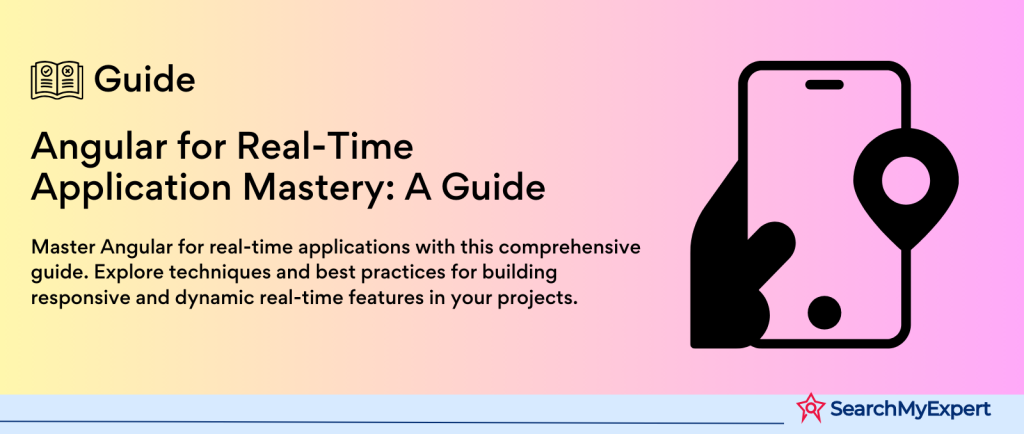Transitioning from AngularJS and WebSockets to Angular for Real-Time Applications
In the evolving landscape of web development, technologies continuously adapt and change, leaving some tools behind while pushing others to the forefront. AngularJS, once a cornerstone for dynamic web applications, has seen its end-of-life, signaling a pivotal shift for developers invested in creating cutting-edge, real-time applications. Similarly, while WebSockets have been instrumental in enabling real-time communication between web clients and servers, the advancement in web technologies has brought forth more efficient and scalable alternatives.
As we navigate through these transitions, Angular emerges as a robust, supported, and future-proof framework for developing real-time applications. Angular’s comprehensive ecosystem, real-time capabilities, and continuous updates make it an ideal choice for developers looking to build scalable, high-performance web applications. This transition not only reflects the natural progression of web technologies but also highlights the importance of adapting to more modern frameworks that can better meet today’s development challenges.
Angular, with its component-based architecture, offers a powerful set of tools and features that enhance productivity and facilitate the development of complex applications. Its ability to seamlessly integrate with various real-time data services and new web standards makes Angular a superior choice for developers moving away from AngularJS and WebSockets.
The benefits of transitioning to Angular for real-time applications, providing insights into how Angular’s modern features and capabilities can be leveraged to create more efficient, scalable, and future-proof applications. We will delve into Angular’s real-time data handling capabilities, its support for advanced development practices, and how it compares to the limitations of AngularJS and WebSockets, setting the stage for a comprehensive guide on embracing Angular for your next real-time project.
Understanding WebSockets and Angular’s WebSocket Observables
Real-time communication in web applications has become a standard expectation for users seeking instant interactions and updates. At the heart of such dynamic interactions lie WebSockets, a powerful technology that enables open, interactive communication sessions between a user’s browser and a server. With WebSockets, data can be transferred instantly in both directions as soon as a connection is established, without the need for repeatedly initiating HTTP requests. This technology is particularly beneficial for applications requiring real-time functionalities, such as chat applications, live sports updates, and financial trading platforms.
The Benefits of WebSockets for Real-Time Communication
- Low Latency:
WebSockets significantly reduce the latency seen in traditional HTTP communications, ensuring that data is exchanged between clients and servers almost instantaneously. - Bi-directional Communication:
Unlike HTTP, which is uni-directional, WebSockets allow for full-duplex communication, meaning data can flow in both directions simultaneously. - Reduced Overhead:
After the initial handshake, the data frames required to transfer data in WebSockets are very small, reducing the amount of overhead and enhancing performance.
Introducing Angular’s WebSocket Observables
While WebSockets provide the foundation for real-time communication, Angular enhances this capability through the integration of WebSocket Observables, part of the RxJS library that Angular heavily relies on. Observables are a powerful pattern that deal with asynchronous data streams, making them perfectly suited for handling WebSocket messages.
Angular’s WebSocket support encapsulates the complexity of WebSockets by providing a simple way to work with real-time data streams. By utilizing WebSocket Observables, developers can easily send and receive messages over a WebSocket connection with minimal boilerplate code. This integration allows for a more declarative approach to handling real-time data, where developers can subscribe to data streams and react to new messages as they arrive, enriching the user experience with dynamic and responsive content.
Using Angular’s WebSocket Observables
Implementing WebSocket Observables in Angular involves creating a service that connects to a WebSocket server and listens for messages. Here’s a simplified example to illustrate the process:
- Establishing a WebSocket Connection:
Utilize Angular’s RxJS library to create a WebSocket subject that connects to the server. - Sending Messages: Use the WebSocket subject to send messages to the server.
- Receiving Messages: Subscribe to the WebSocket subject to listen for incoming messages from the server and react accordingly.
This approach not only simplifies the development of real-time applications but also integrates seamlessly with Angular’s ecosystem, allowing for a more structured and maintainable codebase.
Setting Up Angular Development Environment with WebSockets
Embarking on the development of a real-time application with Angular and WebSockets begins with setting up a robust development environment. This setup ensures that you have all the necessary tools and libraries at your disposal, facilitating the seamless integration of real-time functionalities into your Angular applications. Follow this comprehensive guide to install and configure the Angular CLI, including WebSocket libraries, and to create a new Angular project geared towards real-time communication.
Installing Angular CLI
The Angular CLI (Command Line Interface) is a powerful tool that simplifies the process of creating, managing, and deploying Angular applications. To install the Angular CLI, you need to have Node.js and npm (Node Package Manager) installed on your machine. With these prerequisites in place, open your terminal or command prompt and run the following command:
“npm install -g @angular/cli”
This command installs the Angular CLI globally, allowing you to access it from anywhere in your system.
Including WebSocket Libraries
Although Angular provides built-in support for handling WebSockets through RxJS Observables, you might sometimes need additional functionality offered by external WebSocket libraries. A popular choice is the rxjs/webSocket module, which provides a WebSocket subject that simplifies working with WebSocket connections. To include this in your project, ensure you have RxJS installed, which is typically included by default in new Angular projects.
For more specialized use cases, you might consider third-party libraries such as socket.io-client if your server uses Socket.IO, which offers additional features over standard WebSockets. Install it using npm:
“npm install socket.io-client”
Creating a New Angular Project
With the Angular CLI installed, you can now create a new Angular project by executing the following command:
“ng new real-time-app”
Replace real-time-app with the name of your project. This command creates a new directory with the project name, sets up the Angular project with a default app module, and installs necessary Angular npm packages.
Managing Assets for Real-Time Functionality
To incorporate real-time functionality into your Angular project, you’ll need to manage various assets, including scripts, styles, and WebSocket services. Angular CLI projects follow a specific structure, making it easy to organize your assets:
- Scripts and Styles:
Store global styles in the src/styles.css (or .scss for Sass) file, and add third-party scripts to the angular.json configuration file under the scripts array to include them in your build. - WebSocket Services:
Create services to manage WebSocket connections. Use the Angular CLI to generate a new service:
Bash
“ng generate service real-time”
Replace real-time with the name of your service. This command creates a service where you can encapsulate the logic for initiating WebSocket connections, sending messages, and subscribing to data streams.
- Environment Configuration: Utilize the environment.ts and environment.prod.ts files in the src/environments folder to configure different WebSocket endpoints for development and production environments, ensuring your application connects to the correct server.
By following these steps, you set a strong foundation for your Angular application, ready to integrate real-time functionalities using WebSockets. This setup not only streamlines the development process but also ensures that your application is scalable and maintainable, capable of handling the dynamic requirements of real-time communication.
Building Real-Time Components and Services in Angular
The essence of integrating real-time functionalities into an Angular application lies in the creation of dynamic components and services that can efficiently manage real-time data communication and updates. This involves subscribing to WebSocket Observables to receive data streams and building services that handle the complexities of data communication. Follow this guide to craft components and services that breathe life into your real-time Angular application.
Creating Real-Time Angular Components
Components in Angular act as the building blocks of your application’s UI, making them ideal for displaying real-time data. Here’s how to create a component that subscribes to WebSocket Observables:
- Generate a New Component:
Use the Angular CLI to generate a new component for displaying real-time data. - Replace real-time-display with the name that best describes your component’s functionality.
- Subscribe to WebSocket Observables: In your component, inject the service responsible for managing WebSocket connections.
Building Services for Real-Time Data Communication
Services in Angular are singleton objects that provide a centralized place to manage data and logic across components. To handle real-time data communication:
- Generate a New Service: Create a service dedicated to managing WebSocket connections and data communication.
- Implement WebSocket Connection:
Utilize the rxjs/webSocket module to establish a WebSocket connection and manage data streams within your service: - In this service, webSocket creates a WebSocket subject pointing to the URL defined in your environment configuration. getData returns an Observable that components can subscribe to receive real-time data. sendMessage allows sending messages to the server through the WebSocket connection.
- Environment Configuration: Don’t forget to define your WebSocket server URL in the environment.ts and environment.prod.ts files:
By following these steps, you construct a solid foundation for your Angular application to handle real-time data communication effectively. Components subscribing to WebSocket Observables ensure that your UI stays responsive and updated with the latest data, while centralized services manage the underlying data streams and communication protocols. This architecture not only promotes a clean separation of concerns but also enhances the scalability and maintainability of your application, paving the way for a seamless real-time user experience.
Data Handling and Synchronization in Real-Time Angular Applications
Efficient management of real-time data flow and ensuring consistency across users are critical challenges in developing real-time applications. These challenges necessitate strategic planning and implementation to handle data updates, filtering, and error handling effectively. By adopting robust data handling and synchronization strategies, developers can enhance the reliability and user experience of real-time Angular applications. This section delves into these strategies and techniques.
Managing Real-Time Data Flow
- State Management:
Implement state management solutions like NgRx or Akita to manage the application state in a predictable manner. These libraries offer powerful mechanisms for managing the flow of data and state changes in your application, making it easier to track and sync real-time data across components. - Data Caching:
Cache data locally to improve performance and reduce server load. Caching strategies can help in minimizing the impact of network latency and ensuring that the application remains responsive, even in fluctuating network conditions. - Optimistic Updates: Implement optimistic UI updates to enhance the user experience. By updating the UI as though the requested operation has already succeeded, you provide immediate feedback to users, synchronizing the actual data with the server in the background.
Ensuring Consistency Across Users
- Conflict Resolution:
Develop a conflict resolution strategy to handle concurrent updates. Last-write wins or versioning techniques can be employed to resolve conflicts and ensure data consistency across users. - Real-Time Data Broadcasting: Utilize WebSocket or similar technologies to broadcast data changes to all connected clients, ensuring that all users have the most up-to-date information. This approach helps in maintaining consistency across user sessions.
- Event Sourcing:
Consider using event sourcing patterns to maintain a history of changes. This pattern enables the application to reconstruct the state by replaying events, facilitating easier debugging and consistency checks.
Handling Updates, Filtering, and Error Handling
- Incremental Updates: Instead of refreshing the entire dataset, send incremental updates or deltas. This reduces the amount of data transferred over the network and improves the efficiency of data synchronization.
- Data Filtering:
Implement server-side and client-side filtering mechanisms to manage the volume of data being transmitted. This ensures that only relevant data is sent to each client, reducing bandwidth usage and improving performance. - Error Handling:
Robust error handling mechanisms are crucial in real-time applications. Implement retries, fallback strategies, and user notifications to handle errors gracefully. Use RxJS operators like catchError and retry to manage errors in data streams effectively. - Rate Limiting and Debouncing:
To prevent overwhelming the server with frequent requests or updates, implement rate limiting and debouncing techniques. These techniques help in optimizing the performance and scalability of your real-time application.
Testing and Deployment of Real-Time Angular Applications
Thorough testing is paramount in ensuring that real-time functionalities within Angular applications operate flawlessly across various use cases. It involves a multifaceted approach encompassing unit testing, integration testing, and end-to-end testing, specifically tailored to accommodate the complexities of WebSockets and real-time data flow. Following a rigorous testing regimen leads to a robust application, ready for deployment to production environments. This final step outlines the testing methodologies and deployment strategies vital for real-time Angular applications.
Testing Real-Time Functionality
- Unit Testing: Focus on testing individual components and services in isolation. For components subscribing to WebSocket Observables, mock the service to return expected data and verify the component reacts as intended. Angular’s testing utilities alongside Jasmine or Jest provide a solid foundation for mocking dependencies and observing component behavior.
- Integration Testing: Evaluate the interaction between components and services to ensure data is correctly passed and handled within the application. This includes testing the integration with WebSocket services to confirm that data flows seamlessly from the backend to the frontend and vice versa. Tools like Angular TestBed facilitate the simulation of real-world scenarios and interaction patterns.
- End-to-End Testing:
Utilize Cypress or Protractor for end-to-end testing to simulate user interactions in a real-time context. This involves testing the application as a whole, ensuring that real-time updates are accurately reflected in the UI and that user actions trigger the appropriate real-time responses. Consider scenarios such as simultaneous updates from multiple users and network disruptions to assess the application’s resilience and real-time synchronization capabilities.
Considerations for WebSocket Testing
- Mocking WebSocket Servers: Use libraries like WebSocket-Node or mock-socket to create mock WebSocket servers. This allows for testing the application’s WebSocket logic without the need for an actual server, enabling the validation of connection handling, message sending, and receiving.
- Testing Connection Stability:
Simulate network instabilities and reconnect scenarios to ensure the application gracefully handles connection drops and automatically reconnects, maintaining a seamless user experience. - Data Consistency Checks: Implement tests to verify that data remains consistent across clients after real-time updates, especially in applications that rely heavily on user collaboration.
Deploying Your Real-Time Angular Application
- Optimization:
Before deployment, optimize your Angular application using the Angular CLI’s build optimization tools. Run ng build –prod to enable production mode, which includes minification, uglification, and ahead-of-time (AOT) compilation, enhancing performance. - Environment Configuration: Ensure that your production environment variables, including WebSocket server URLs, are correctly set in the environment.prod.ts file. This configuration should reflect the actual endpoints your application will interact with in the production environment.
- Server Selection: Choose a hosting solution that supports WebSocket connections. Cloud platforms like AWS, Google Cloud, and Heroku offer environments compatible with real-time applications, providing scalability and reliability.
- Continuous Integration/Continuous Deployment (CI/CD): Implement CI/CD pipelines to automate the testing and deployment processes. Tools like Jenkins, Travis CI, or GitHub Actions can automate the build, test, and deploy phases, ensuring that every code change is automatically deployed to production after passing all tests.
- Monitoring and Analytics:
After deployment, use monitoring tools to track application performance and user interactions. This data is invaluable for identifying issues in real-time, understanding user behavior, and guiding future development efforts.
Exploring Advanced Features and Libraries for Real-Time Angular Applications
To elevate the capabilities of real-time Angular applications, leveraging advanced WebSocket features and integrating with popular libraries and tools are essential steps. Advanced features like authentication, authorization, and message negotiation ensure secure and efficient communication, while external libraries can significantly enhance the application’s real-time functionality. This exploration into advanced features and recommended libraries will guide you in enriching your Angular application with sophisticated real-time capabilities.
Advanced WebSocket Features
- Authentication and Authorization:
Secure WebSocket connections are paramount, especially for applications handling sensitive information. Implement token-based authentication (such as JWT) to establish a secure connection. Upon establishing a WebSocket connection, send an authentication token to the server, which validates the token before proceeding with any data exchange. For authorization, manage permissions on the server-side to control access to different types of messages and data, ensuring users only receive data they’re authorized to access. - Message Negotiation:
Efficiently managing the types and formats of messages exchanged over WebSocket connections can significantly improve performance. Implement protocols for message negotiation to determine the most suitable message format (JSON, XML, binary, etc.) based on the client’s capabilities and preferences. This can include compressing messages to reduce latency for high-volume data or selecting between different data serialization formats for efficiency.
Recommended Libraries and Tools
- Socket.IO:
Although not a native WebSocket library, Socket.IO is widely used for real-time web applications due to its ease of use, reliability, and fallback options. It provides an event-driven API that works across various platforms, browsers, and devices. Socket.IO automatically upgrades the connection to WebSocket if possible, but can also use HTTP long polling as a fallback, ensuring compatibility with environments where WebSockets are not supported. - RxJS WebSocketSubject:
For applications already utilizing RxJS, the WebSocketSubject class is a powerful tool for managing WebSocket connections as part of the Reactive programming model. It simplifies sending and receiving messages over WebSockets, allowing developers to apply RxJS operators to WebSocket messages, facilitating complex data flow transformations and error handling. - NGXS or NgRx WebSockets Plugin: For Angular applications using state management libraries like NGXS or NgRx, plugins such as NGXS WebSocket plugin or creating custom NgRx effects for WebSockets can streamline the integration of real-time data into the application’s state management. These plugins provide a structured way to handle WebSocket data within the state management framework, making it easier to maintain consistency and react to real-time updates.
- AngularFire: For projects leveraging Firebase, AngularFire provides a convenient way to integrate Firebase’s real-time database or Cloud Firestore into Angular applications. Firebase’s real-time capabilities, combined with AngularFire’s integration, allow for effortless synchronization of data across clients, providing a robust solution for applications requiring real-time collaboration or updates.
- Auth0 for Authentication: Auth0 offers a comprehensive identity management solution that can be integrated with Angular applications for authentication and authorization. When combined with WebSockets, Auth0 can secure real-time communication channels, ensuring that only authenticated users can subscribe to updates and interact with the application in real-time.
Conclusion
The journey from conceptualizing to deploying a real-time application with Angular encompasses mastering a variety of skills and technologies. We’ve traversed the landscape of Angular’s ecosystem, exploring the setup of development environments, diving into the nuances of WebSockets for real-time communication, and understanding the intricacies of data handling and synchronization. Through detailed discussions on testing methodologies and deployment strategies, this guide aims to equip developers with the knowledge and tools necessary to build robust, efficient, and secure real-time applications.
By leveraging advanced WebSocket features like authentication, authorization, and message negotiation, and integrating with popular libraries and tools, developers can enhance the functionality, reliability, and user experience of their real-time applications. Angular, with its rich ecosystem and comprehensive support for real-time data handling, stands out as a formidable framework for developing modern web applications that require dynamic content delivery and instantaneous user interaction.
As we conclude this comprehensive guide, it’s clear that the development of real-time applications with Angular is not just about writing code. It’s about creating seamless, engaging experiences that connect users across the globe in real time. Whether you’re building chat applications, live sports updates, financial trading platforms, or collaborative tools, the principles and practices outlined in this guide will serve as your roadmap to success in the ever-evolving landscape of web development.
Empower your development team with Angular JS Development Service Companies.
Table of Contents
Toggle






